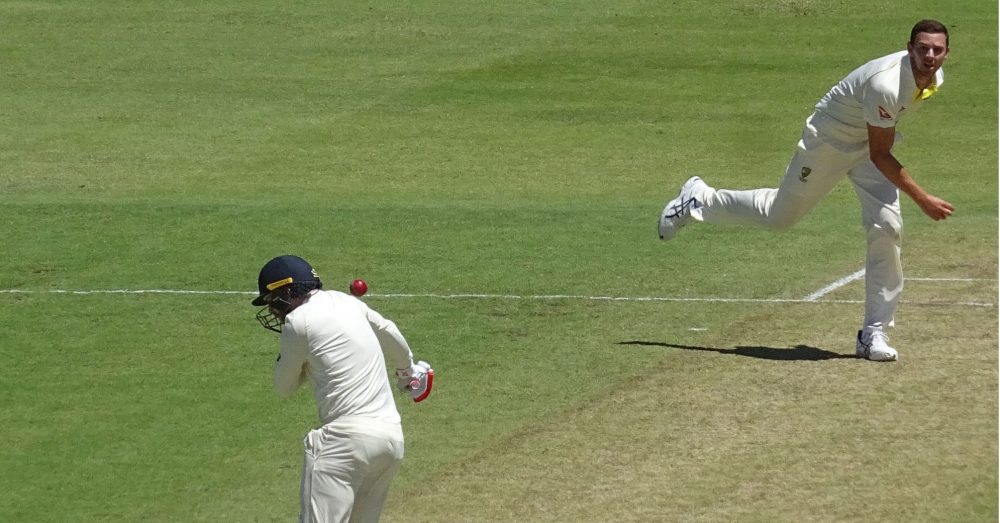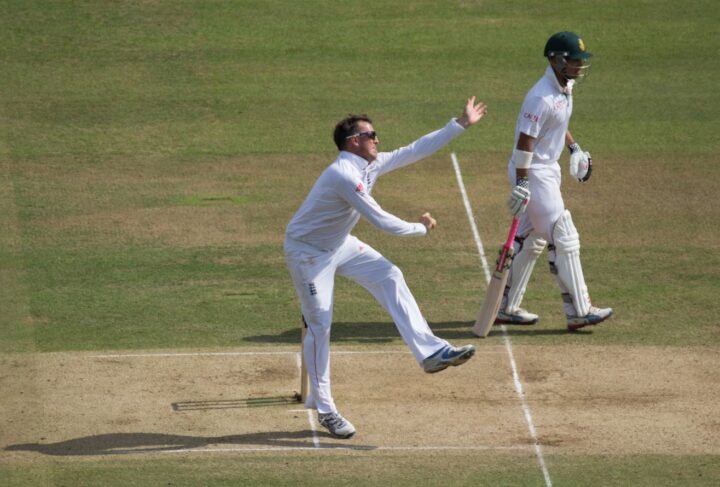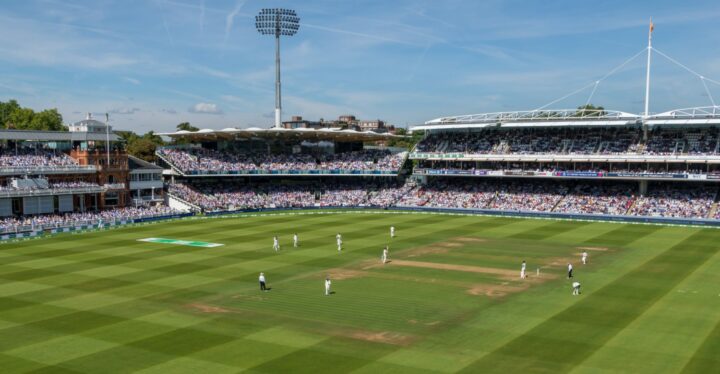After the retirement of Bob Willis, English cricket was criticised for not producing enough genuinely quick bowlers. The standard criticism was that the heavy county workload meant that potential fast bowlers had to cut down on their pace and develop into fast-medium seamers to prolong their career. As England fans, we spent too long watching our seamers struggling in the Ashes while the Australians compiled vast totals. The standard complaint was that we lacked any genuine pace. And the same has been true in plenty of other overseas Test series as well.
I first began to watch cricket in the mid to late 80s, and didn’t really appreciate the nuances of fast bowling until a bit later. Our fastest bowler at the time was probably Graham Dilley. Although this was well before the speed gun era, watching somewhat limited clips of him on YouTube, he definitely appears “sharp.” I would guess he was capable of bowling in the late 80s or so at his peak – not express but probably quick enough.
However, Devon Malcolm, who debuted in 1989, was probably the first ‘genuine quick’ I saw play for England – although he was frequently overlooked by the selectors due to his periodic inaccuracy. My first Test match, in 1992, featured both Malcolm and the quickish Chris Lewis. My memories of the game really focus upon David Gower hitting a fine 73, his last fifty in England colours, and rather bizarrely Ian Salisbury also scoring a 50. I did get Dev’s autograph though.
Malcolm was a brutal bowler, none more so than in 1994 against South Africa, and it seems bizarre that he did not play more often. “Syd” Lawrence was another bowler of genuine pace whose career was sadly curtailed due to a horrendous knee injury suffered in New Zealand. England did have a couple of pace options available, therefore, in the late 80s through to the mid 90s, even if the selectors at the time seemed reluctant to pick them.
Darren Gough’s selection in 1994 was exciting for a number of reasons, not least his pace, aggression, and ability to make opposing batters jump around. Were England finally selecting some pace bowlers able to threaten the opposition on benign surfaces? Gough’s partnership with Andrew Caddick – who could also bowl in the high 80s earlier in his career – contributed a great deal to England’s improvement as a Test side under Nasser Hussain.
Gough’s career coincided with the introduction of speed guns, when it became possible to compare out and out fast bowlers with their slightly slower colleagues. Goughie was also the first English bowler to master reverse swing with his fairly low and skiddy action. Reverse swing was supposedly invented on the dry pitches in Pakistan, and Gough developed the skill after watching Waqar and Wasim move the old ball to devastating effect.
Having Gough in the side brought a new dimension to the England Test XI, and his success seemed to inspire more English bowlers to bowl flat out: the 2005 Ashes saw an England attack including Messrs Harmison, Flintoff and Simon Jones, who were all capable of devastating pace. Harmison and Flintoff both took over 200 test wickets, and Jones, another formidable exponent of reverse swing, was sadly prevented from playing after that year’s Ashes series due to persistent injuries.
The 2005 attack was the most consistently fast of any England line-up that I have seen, and it is a shame that inconsistency and injury meant that they only played together on a few occasions. We shouldn’t forget, by the way, Matthew Hoggard’s crafty outswing which provided contrast to a superb all-round seam attack.
The last 10 years or so have been dominated by Jimmy Anderson and Stuart Broad – technically two of the finest bowlers to play for England. However, they have lined up alongside some genuinely rapid bowlers, Mark Wood probably being the out and out quickest. This, again, has provided much-needed balance to England’s team.
With Jofra Archer and Olly Stone also bowling in excess of 90mph (and Broad and Anderson bound to retire at some point), there is the intriguing prossibility of England picking three out-and-out fast bowlers in the same team for the first time. In fact, England do seem well served with pace at the moment, with Brydon Carse, Saqib Mahmood and Jamie Overton all being at the sharper end. One hopes they can avoid the chronic injury problems that seem to plague a lot of quicker bowlers.
Pace isn’t everything, of course. It needs to be allied with movement and accuracy. However, it is interesting to speculate whether the onset of the speed gun and the increase in T20 may encourage more bowlers to strain for extra mph. As Mark Wood and Jofra Archer have proven, pace can be as devastating a weapon in the shortest form as it can in Test matches. What’s more, they only have to bowl a maximum of four overs rather than come back for second and third spells, so they can really bend their back.
Let’s hope that England’s best quicks stay loyal to the red ball game and only specialise in the shortest forms when, like Tymal Mills, injuries force their hand. After all, nothing makes cricket aficionados smile like watching Test batsmen hop around. Chin music, anyone?
Rob Stephenson









The key seems to be fitness with several of these bowlers. I suspect a number of them will stick to the relatively easy pickings of t20.
Archer bowling to Steve Smith and Labuschagne was the fastest spell of bowling I’ve ever seen by an England bowler. Maddening that Root bowled him into the ground. Malcolm was exceptionally fast in his 9-57 spell, too.
Flintoff bowled two overs in his career – to Ponting in 2005 and Kallis in 2008 – that proved too quick for two of the finest batsmen in history.
These are my fast bowling highlights for England. The fastest spell I ever saw though was Waqar Younis for Surrey in the evening of a Natwest Trophy game in the early 90s. No idea exactly when or who against, but I remember him taking 5 for virtually none with those terrifying yorkers to win what seemed a lost cause.
I loved watching Goughie but never thought he was particularly quick.
Gooch bowled Malcolm into the ground, a result of picking six batsmen (none of whom except Gooch himself could usually offer even a few overs with the ball). Flintoff also often carried a heavy workload – people tend to fixate on the match against SL when he was captain but when he was younger Flintoff was used as a stock bowler in a four-man attack.
Root’s mishandling of Archer was bad and he should have been more sympathetic – but the armiy of support staff are more to blame. What are the head coach, bowling coach and fitness coach paid for?
You’d have thought there might have been some sort of plan, wouldn’t you…?
I hadn’t remembered Malcolm being overbowled (I’d remembered him being underselected), but the stats certainly bear it out. I just had a look through and he bowled 212 balls per Test. Archer, who was certainly horribly overbowled, has bowled 200. He bowled over 30 overs in an innings 13 times in the first 18 months of his Test career (which was entirely or almost entirely under Gooch) and only 3 times in the last 6.5 years. Very marked indeed. Well remembered!
I was at Lord’s when Flintoff bowled that idiotic spell – something like 17 overs on the spin separated only be tea, I can’t remember the exact details. I’m sure there were plenty of other contributing factors to his subsequent injury problems but I think it’s fair to say this was the single largest factor. He was horribly overweight at the start of his career, too. I think the effects of this caught up with him later.
It’s interesting that in his breezeblock of an autobiography, Steve Waugh says of Devon Malcolm that there were “any number” of medium pacers that the Aussies would have rather faced. He questions England’s selection policy of the time – not difficult.
I’m probably a couple of years older than the author and my first Test live was watching Bob Willis’ final match.
I hope Wood stays fit as he is exciting.
The fastest spell I ever say was Shoaib Akhtar playing a T20 for Worcestershire. The keeper must have easily been 30 yards back and was leaping for every take.
It seems to me quickies are a pretty random occurance. I remember in the 70’s there was a campaign to find a bevy of quick bowlers sponsored by the eccentric but always interesting Lord Ted. He went to hundreds of schools countrywide and assessed using a largely physical formula potential talent, the best of which after some nets he invited for special schoolling. I remember a couple of teenagers were taken on by the counties but nothing came of them or any of the rest as far as I know. So much young talent seems to fall by the wayside in so many sports during the selection procedure.
Great comments in this thread. Thanks to all.
Are you supporting England this week?
I was finding it hard to support England while Graves and Harrison were in situ destroying our game while taking the credit for the rare successes. Those who actually follow English cricket, and therefore know what they’re talking about, will know that they’ve now moved on. Thankfully, we now have two people in charge who care about the counties and the first class game.
Do try to keep up. The departure of Harrison and Graves was, after all, probably the biggest / most important news in English cricket in recent times.
Ban this troll.
I’ve already told Tom that he’s not welcome on this forum. He’s the only person, in this blog’s 15 year existence, that I’ve ever banned. We’ve had plenty of people who’ve disagreed with the majority, and challenged the prevailing narrative, but Tom is different. He’s an Australian nationalist with a chip on his shoulder about the English. For him, cricket isn’t just a pleasurable pastime and a friendly rivalry where good natured banter goes back and forth. He believes that cricket is an expression of (what he sees as) Australia’s national superiority. He therefore doesn’t debate intelligently or with nuance. He debates with prejudice. And that’s why he’s not welcome.
I’d really love to know if the quicks ‘of old’ where as quick in the air.
I know wickets were different but surely the strength and conditioning of modern bowlers means in the air, they win on a speed gun?
This is an informative blog. Thank you for this useful blog about international cricket.